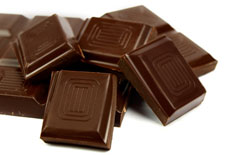An ancient believe was that chocolate strengthens the heart
As early as the 18th century chocolate was believed to ‘strengthen the heart’. In 1999 we found that chocolate is a rich source of flavan-3-ols (catechins), a subclass of flavonoids. The flavan-3-ols in chocolate are a component of cocoa.
Cocoa associated with lower CVD mortality
 The Zutphen Elderly Study found that a high intake of cocoa was associated with a low risk of CVD. The median cocoa intake in the highest group was 4.2 g/d, which equals approximately 10 g of dark chocolate per day. These men had a 50% lower 15-year CVD mortality compared to those who did not use cocoa.
The Zutphen Elderly Study found that a high intake of cocoa was associated with a low risk of CVD. The median cocoa intake in the highest group was 4.2 g/d, which equals approximately 10 g of dark chocolate per day. These men had a 50% lower 15-year CVD mortality compared to those who did not use cocoa.
Epicatechin
The association of cocoa with CVD mortality could be due to epicatechin, one of the major monomeric flavan-3-ols. Epicatechin intake was inversely related to CVD mortality in the Zutphen Elderly Study. Evidence from controlled experiments in people shows that epicatechin has favorable effects on endothelial function, blood pressure and insulin resistance. These risk factors might explain the inverse association between cocoa intake and fatal CHD.
